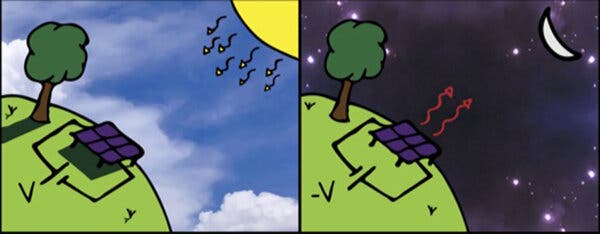New research is allowing solar cells to work at night.

Image credits Tristan Deppe, Jeremy Munday, (2020), ACS Photonics.
Although it sounds like fantasy, Jeremy Munday, a professor in the Department of Electrical and Computer Engineering at the University of California (UC) Davis says it’s completely possible. In fact, a new study by Munday and graduate student Tristan Deppe describes a specially-designed photovoltaic cell that could generate up to 50 watts of power per square meter at night.
Un-solar cells
“A regular solar cell generates power by absorbing sunlight, which causes a voltage to appear across the device and for current to flow. In these new devices, light is instead emitted and the current and voltage go in the opposite direction, but you still generate power,” Munday said.
“You have to use different materials, but the physics is the same.”
The whole system relies on the property of physical bodies to radiate heat to their surroundings (if these are cooler). In essence, it works as a reverse to a traditional solar cell, which absorbs light and energy from the sun.
Munday’s approach cashes in on the fact that outer space is a very cold place. Therefore, if you take a warm object and point it at the night’s sky, it will radiate out heat as infrared light — this mechanism has been used for nighttime cooling for hundreds of years now. In the last five years, Munday explains, there has been a lot of interest in devices that can do this during the daytime (by filtering out sunlight or pointing away from the sun).
Another kind of device, called a thermoradiative cell, can generate power by radiating heat to its surroundings. Research into such cells mostly focuses on applying them to capture waste heat from engines or other applications to later convert into useful energy. Munday and Deppe, however, adapted them for use in the night-time ‘solar’ panels.
“We were thinking, what if we took one of these devices and put it in a warm area and pointed it at the sky,” Munday said.
It’s a simple premise, but pointing a thermoradiative cell towards the night’s sky was enough to generate some electricity. Munday believes that it will probably also work during the day, assuming it’s placed in the shade or at least pointed away from the sun.
One advantage this approach has over conventional solar panels is that a thermoradiative cell can work throughout the day, potentially serving as a source of energy to complement traditional solar and wind arrays. Still, Munday and Deppe are currently working on improving the output and efficiency of these devices to get them ready for wide-scale use.
The paper “Nighttime Photovoltaic Cells: Electrical Power Generation by Optically Coupling with Deep Space” has been published in the journal ACS Photonics.









